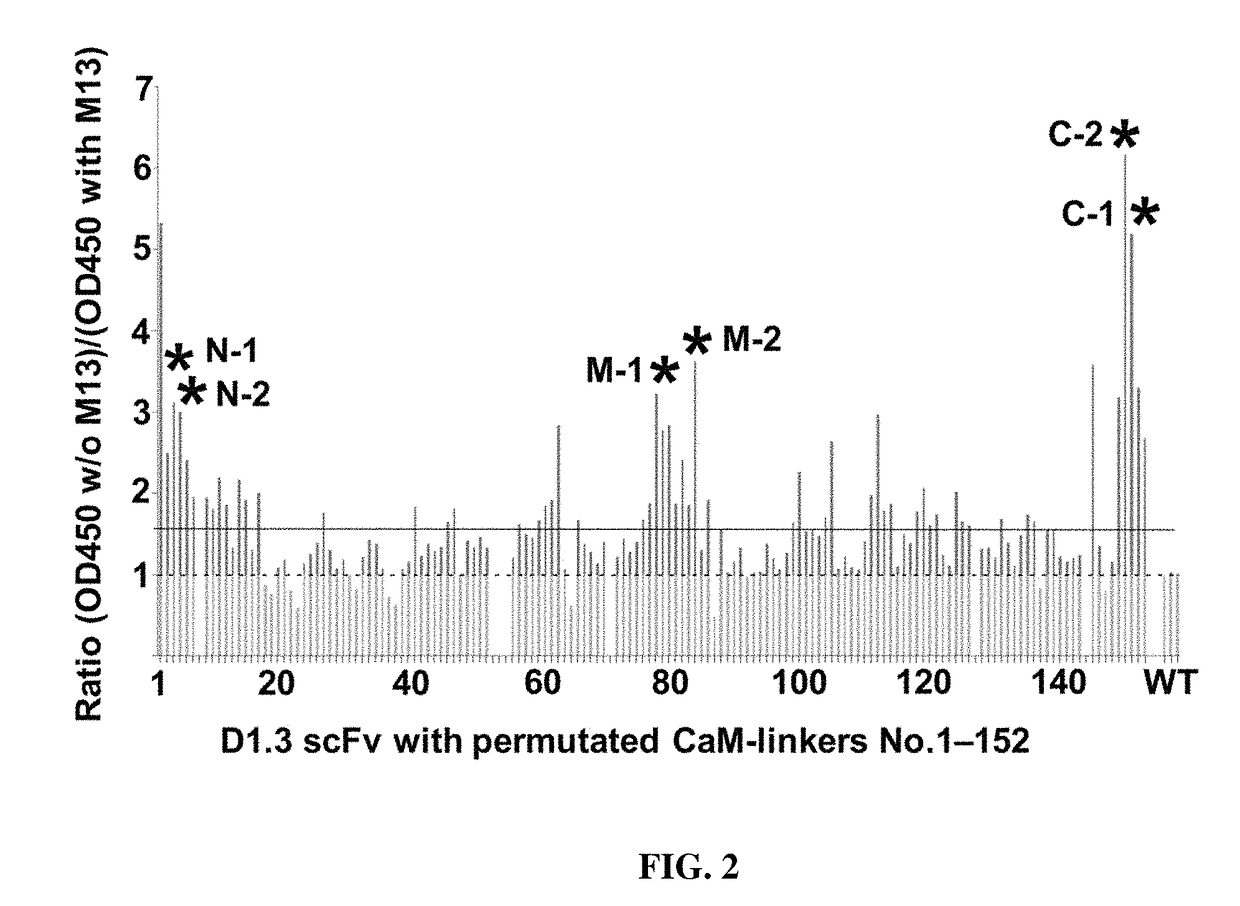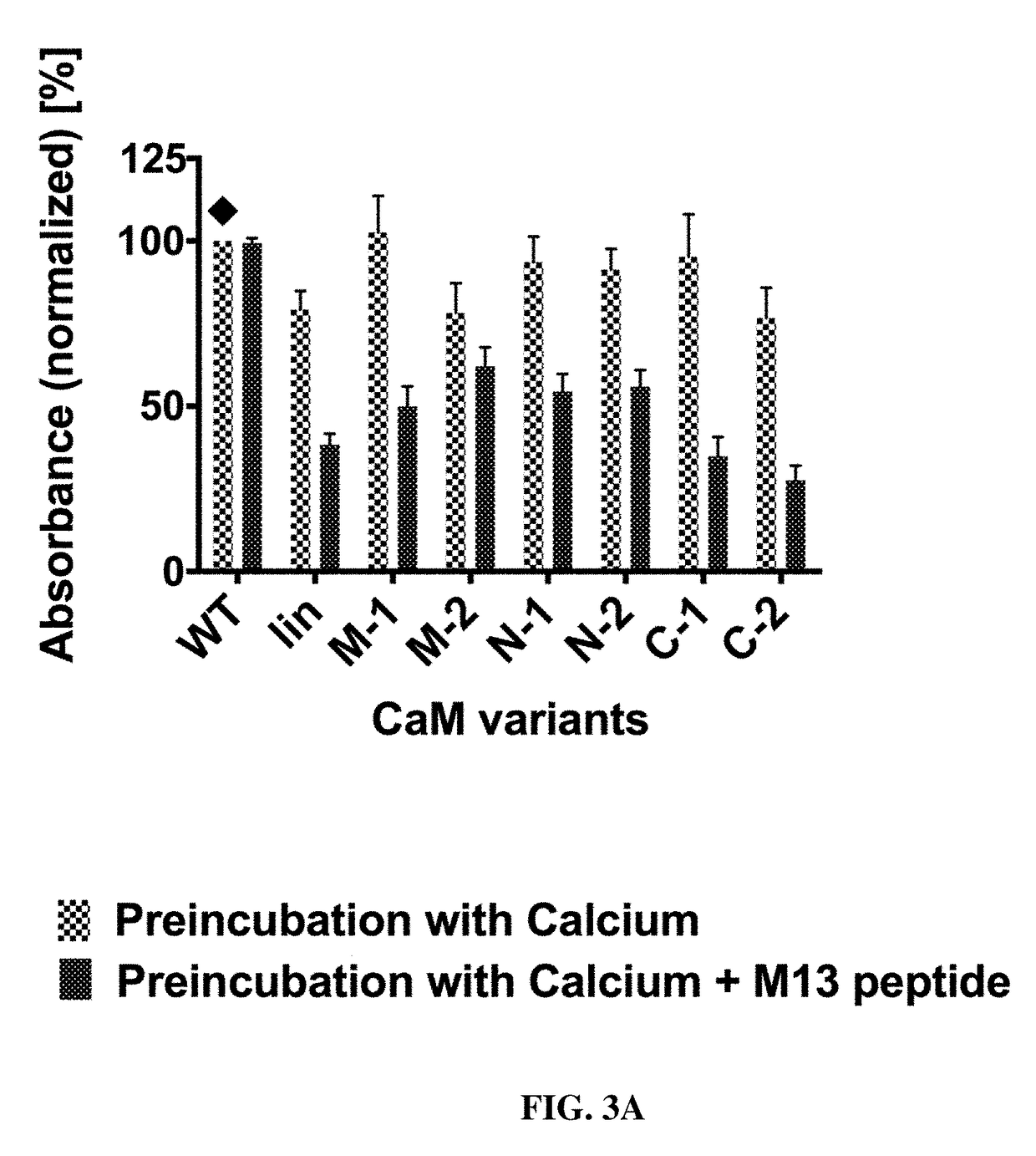Composition and method for affecting the binding of antigen-binding polypeptides to antigens
a polypeptide and antigen technology, applied in the direction of peptides, transferases, peptide sources, etc., can solve the problems of affecting the folding, integrity or viability of eluted materials, affecting the fluorescence effect, and the solution must be calcium-free, so as to reduce the binding of polypeptides and enhance binding
- Summary
- Abstract
- Description
- Claims
- Application Information
AI Technical Summary
Benefits of technology
Problems solved by technology
Method used
Image
Examples
example 1
n of Permutated Calmodulin-scFv-Fusions
[0156]To identify the optimal arrangement of calmodulin to achieve the effect of a conformation change affecting antibody binding when inserted between the VH and VL antigen binding regions of an antibody, a gene library of 152 different variants representing all possible insertion points throughout a circularized calmodulin molecule was generated.
[0157]First, the gene encoding for human calmodulin (SEQ ID NO: 66) was optimized for recombinant expression in E. coli, flanking sequences encoding for BamHI recognition sites were added and the construct was synthesized by DNA2.0 (Menlo Park, USA). Circular permutation of the gene was performed by polymerase chain reaction (PCR) (FIG. 1). First, the plasmid bearing the gene of interest was amplified in E. coli NEB® 5-alpha (New England Biolabs, Frankfurt a.M., Germany) and purified by using the NucleoBond® Xtra Maxi Plasmid Purification Kit (Macherey-Nagel, Duren, Germany). Next, the gene encoding f...
example 2
ation of Switchable Anti-Lysozyme scFv-Calmodulin-Variants
[0158]Calmodulin conformation has been shown to change when binding to the calmodulin-binding peptide M13 (residues 577-602 of skeletal muscle myosin light chain kinase). To test the influence of M13 peptide on the calmodulin-scFv fusion proteins, all constructs were produced in E. coli in microtiter plate format. Cells harboring the desired construct were grown overnight at 37° C. and 1000 rpm in 96-well polypropylene U-bottom plates (Greiner Bio-One, Solingen, Germany) in 180 μL 2×YP-GK-medium (2×YP-medium [16 g L−1 soy peptone, 10 g L−1 yeast extract, 5 g L−1 NaCl, pH 7.0] containing 100 mM glucose and 50 μg / mL kanamycin) per well. The next day, 170 μL fresh medium was inoculated with 5 μL overnight culture and shaken at 1000 rpm for 6 h at 30° C. Protein expression was induced with a final concentration of 0.2 mM IPTG and cultures were incubated overnight at 25° C. Bacteria were harvested by centrifugation (4000 g, 20 min...
example 3
Evaluation of M13 Peptide-Dependent Release Characteristics of Bound scFv-Fusions
[0161]The calmodulin-mediated change of binding observed in the initial screening was achieved after preincubation with the modulator M13. Next, we designed a release ELISA to test whether M13 peptide binding to the calmodulin linkers can also induce the dissociation of an already established antibody-antigen complex. After an initial binding phase of scFv variants on antigen in calcium-containing buffer, M13 peptide was added, with calcium-only buffer used for control. In parallel, the same scFvs were analysed by the competitive preincubation approach described above (compare Example 2) on the same plate for calibration.
[0162]First, the scFv-CaM-constructs were produced in 500 mL shake flask scale. For protein expression, cells harboring the desired construct were grown overnight at 37° C. and 250 rpm in 30 mL 2×YP-GK-medium (2×YP-medium [16 g L−1 soy peptone, 10 g L−1 yeast extract, 5 g L−1 NaCl, pH 7...
PUM
| Property | Measurement | Unit |
|---|---|---|
| concentration | aaaaa | aaaaa |
| pH | aaaaa | aaaaa |
| pH | aaaaa | aaaaa |
Abstract
Description
Claims
Application Information
 Login to View More
Login to View More - R&D
- Intellectual Property
- Life Sciences
- Materials
- Tech Scout
- Unparalleled Data Quality
- Higher Quality Content
- 60% Fewer Hallucinations
Browse by: Latest US Patents, China's latest patents, Technical Efficacy Thesaurus, Application Domain, Technology Topic, Popular Technical Reports.
© 2025 PatSnap. All rights reserved.Legal|Privacy policy|Modern Slavery Act Transparency Statement|Sitemap|About US| Contact US: help@patsnap.com



